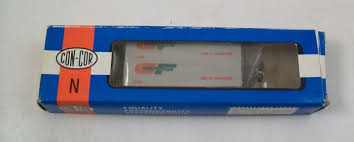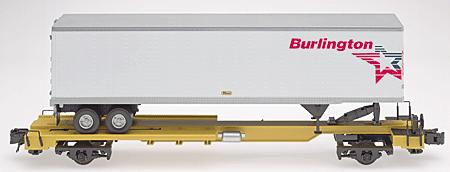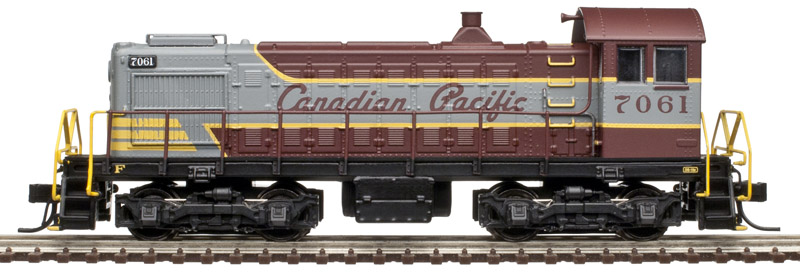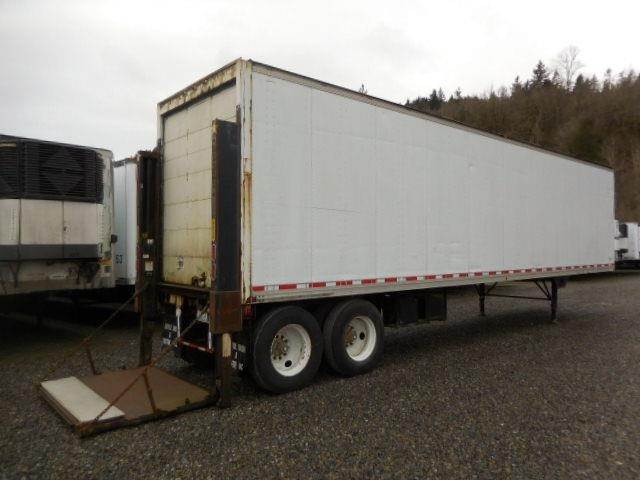Specific Item Information: 2-Pack
Model Information: First appears in the 1973 Con-Cor catalog but may have been available for retail before then. Made by Herpa.
Sold in packs of 2 or 3. Smoothside or Ribbed side. It is a model of a 40 foot box trailer.
Prototype History: 40-foot trailers are still widely used as inter-rail containers. 40 foot is a good length to fit on a 50 foot TOFC flatcar as they provide some room on both ends for safety and sloppy loading. They generally come with a 96" width and are rated for 55,000 pounds. They were never as popular as 48 foot trailers because of the more limited load size. Even 48 foot trailers gave way to 53' models when the laws governing highway transportation changed.
Box vans are known as such for their rectilinear proportions. Their simple design makes them easy to manufacture and maintain.
Box vans are known as such for their rectilinear proportions. Their simple design makes them easy to manufacture and maintain.
Road Name History:  In 1939, CF Inc. started its own truck manufacturing operation, Freightliner, which for decades it operated jointly with White Motor Company. On July 31, 1981, it sold its truck manufacturing business and the Freightliner brand to Daimler AG. In 1981, CF won in a case before the U.S. Supreme Court, Kassel v. Consolidated Freightways Corp.. The court found that Iowa's length restriction on tractor-trailers violated the Dormant Commerce Clause.
In 1939, CF Inc. started its own truck manufacturing operation, Freightliner, which for decades it operated jointly with White Motor Company. On July 31, 1981, it sold its truck manufacturing business and the Freightliner brand to Daimler AG. In 1981, CF won in a case before the U.S. Supreme Court, Kassel v. Consolidated Freightways Corp.. The court found that Iowa's length restriction on tractor-trailers violated the Dormant Commerce Clause.
In 1983, CF Inc. ventured into regional trucking with its spin off Con-Way carriers. Whereas Consolidated Freightways' drivers and dockworkers were unionized, the new Conways (Con-way Central Express (CCX), Con-way Western Express (CWX), Con-way Eastern Express (CEX), etc.) were nonunion, creating tense relations with CF's Teamsters.
On April 3, 1989, CF Inc. purchased Emery Air Freight Corp. merging it with their own CF AirFreight operation and renamed it Emery Worldwide. This, along with Menlo Forwarding, was later sold to UPS.
In 1996, Consolidated Freightways, Inc. spun off its unionized long-haul trucking company, CF MotorFreight, creating two separate publicly traded companies. Parent company, Consolidated Freightways, Inc. was renamed CNF Transportation Inc., reflecting the familiar stock ticker symbol of the company (CNF). CNF retained the Con-Way regional truck companies, Emery Worldwide and a growing logistical systems department.
Consolidated Freightways Corporation filed for Chapter 11 bankruptcy on September 3, 2002, and ceased operations. April 18, 2006, CNF Transportation re-branded itself under its Con-Way image and continues in business today. On October 30, 2015, Con-way Trucking was acquired by Greenwich, CT-based XPO Logistics, Inc.
From Wikipedia

In 1983, CF Inc. ventured into regional trucking with its spin off Con-Way carriers. Whereas Consolidated Freightways' drivers and dockworkers were unionized, the new Conways (Con-way Central Express (CCX), Con-way Western Express (CWX), Con-way Eastern Express (CEX), etc.) were nonunion, creating tense relations with CF's Teamsters.
On April 3, 1989, CF Inc. purchased Emery Air Freight Corp. merging it with their own CF AirFreight operation and renamed it Emery Worldwide. This, along with Menlo Forwarding, was later sold to UPS.
In 1996, Consolidated Freightways, Inc. spun off its unionized long-haul trucking company, CF MotorFreight, creating two separate publicly traded companies. Parent company, Consolidated Freightways, Inc. was renamed CNF Transportation Inc., reflecting the familiar stock ticker symbol of the company (CNF). CNF retained the Con-Way regional truck companies, Emery Worldwide and a growing logistical systems department.
Consolidated Freightways Corporation filed for Chapter 11 bankruptcy on September 3, 2002, and ceased operations. April 18, 2006, CNF Transportation re-branded itself under its Con-Way image and continues in business today. On October 30, 2015, Con-way Trucking was acquired by Greenwich, CT-based XPO Logistics, Inc.
From Wikipedia
Brand/Importer Information: Con-Cor has been in business since 1962. Many things have changed over time as originally they were a complete manufacturing operation in the USA and at one time had upwards of 45 employees. They not only designed the models,but they also built their own molds, did injection molding, painting, printing and packaging on their models.
Currently, most of their manufacturing has been moved overseas and now they import 90% of their products as totally finished goods, or in finished components. They only do some incidental manufacturing today within the USA.
Important Note: The Con-Cor product numbering can be very confusing. Please see here in the article how to properly enter Con-Cor stock numbers in the TroveStar database.
Currently, most of their manufacturing has been moved overseas and now they import 90% of their products as totally finished goods, or in finished components. They only do some incidental manufacturing today within the USA.
Important Note: The Con-Cor product numbering can be very confusing. Please see here in the article how to properly enter Con-Cor stock numbers in the TroveStar database.
Item created by: George on 2017-05-12 16:17:46. Last edited by CNW400 on 2020-05-25 14:38:08
If you see errors or missing data in this entry, please feel free to log in and edit it. Anyone with a Gmail account can log in instantly.
If you see errors or missing data in this entry, please feel free to log in and edit it. Anyone with a Gmail account can log in instantly.









